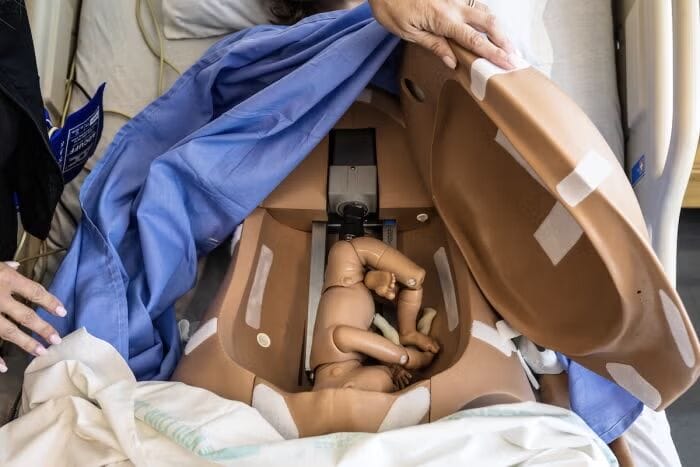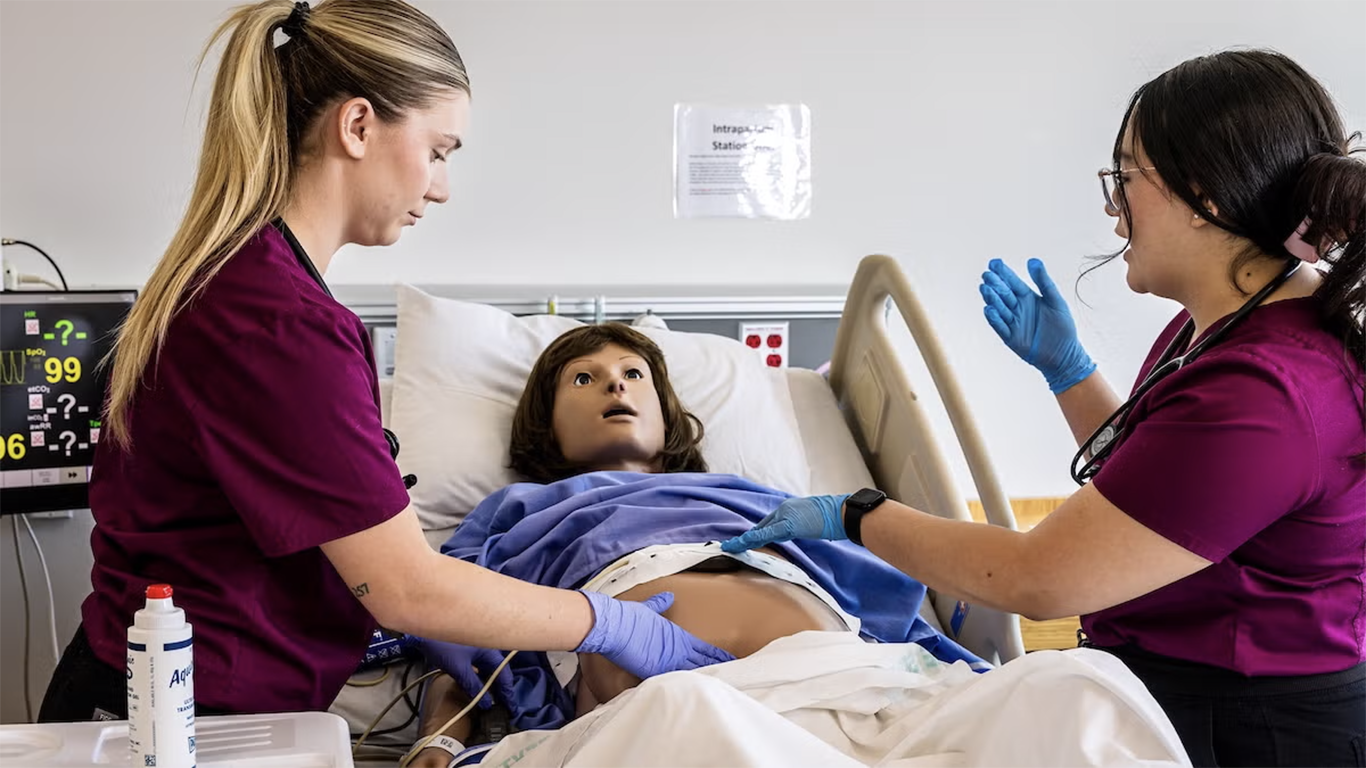It’s 1:07 p.m. when nurses Hanna Troy and Janette Gonzalez walk into the delivery room, where Noelle is waiting to deliver her first child.
They take Noelle’s blood pressure and temperature and ask her a few questions.
“Do you have any allergies?”
“I don’t have any,” Noelle says.
“How are you feeling?”
“I’m just ready to have this baby.”
“What would you rate your pain on a scale of one to 10?”
“When a contraction comes, it’s a nine,” Noelle says.
Troy and Gonzalez gently lift Noelle’s hospital gown, feel her belly and place two monitors on her: One on the tip of the belly to measure her contractions, and a second to keep track of the baby’s heartbeat.
Less than 10 minutes after saying hello, Troy and Gonzalez walk out of the room. Their job is done. A doctor will deliver the baby.
Except, there is no real baby. And Noelle isn’t a first-time mother-to-be. She’s a birth manikin that students within the pre-licensure program of Arizona State University’s Edson College of Nursing and Health Innovation use to gain hands-on experience.
“This is a place where students can make mistakes, learn from them and then apply those lessons in (their jobs),” said Kegan Miller, manager of operations at the Grace Center for Innovation in Nursing Education.
LOCAL NEWS: 100 best places to work and live in Arizona for 2025
INDUSTRY INSIGHTS: Want more news like this? Get our free newsletter here
The manikin, located in the Health Futures Center, has four different bellies that represent stages of gestation.
It can be programmed to have contractions every two to five minutes, and students can read a tachometer, which is used to monitor the fetal heart rate.
The manikin’s voice — and the answers to Troy and Gonzalez’s questions — is supplied by Ashley Thompson, the experiential simulation and education liaison. Thompson sits in a control room down the hall, just a few feet away from the delivery room. Her responses help guide students in determining the care the patient needs in that moment.
Troy and Gonzalez are aiding Noelle in the final stages before her delivery, but Edson’s students can use Noelle as a training aid through all nine months of the pregnancy, including birth and complications after birth.
“You can do physical assessments on being able to feel where the baby is at,” said Jessica Gentes, director and clinical assistant professor at the Grace Center. “And then, additionally, once we get to the point of the labor, the mannequin will actually give physical birth. In some of our simulations, we have what we call postpartum hemorrhage, so we can make the patient actually bleed heavily, and the students would have to manage that scenario. So, the whole gamut can be done.
“To give something like this to our students where we can guarantee they’ll get this type of experience is great. When I was in school, I saw a couple of births, but some students never saw one. But we can provide that now, which is really cool.”

Troy, who received a bachelor’s degree in kinesiology and a master’s degree in medical nutrition from ASU, said working with Noelle was “super realistic.”
“You could actually feel the fetal head,” said Troy, who is working toward a master’s degree in nursing (entry to nursing practice). “With my two prior degrees, I knew that ASU had a ton of good resources, which is why I wanted to come back for my third, but, honestly, nothing to this extent. It’s so valuable to have these like real-life scenarios. I think it really helps prepare you for real-life situations.
“Without having that and just going by a textbook, I think you’d probably be a little shocked the first time you’re with a patient.”
Gonzalez, who has a bachelor’s degree in health sciences and is also pursuing an entry to nursing master’s degree, said being able to talk to Noelle through Thompson’s responses made the simulation seem more real.
“It’s pretty cool to have this at our disposal,” Gonzalez said. “It’s not like we can bring in a pregnant woman here whenever we need them. So, this is really awesome. And being able to feel the different things in the belly and have the manikin talk back to us is really amazing.
“I’m really grateful to ASU for this opportunity.”




